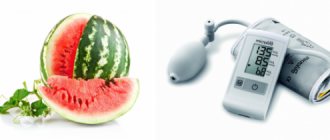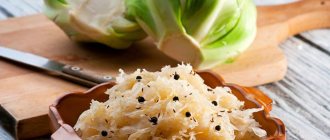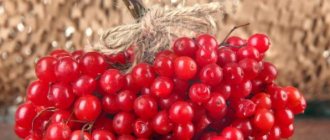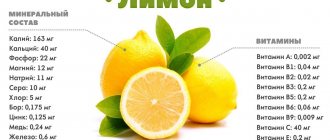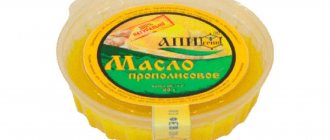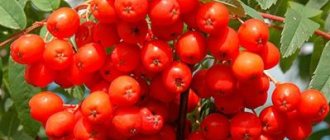Grapes are a unique berry, the fruits and leaves of which have long been used to prepare delicious dishes and drinks. Its use for medicinal purposes is used to combat various diseases, including heart diseases.
On this page we will understand how grapes and blood pressure are related, whether the fruit increases or decreases its performance, and discuss the methods of using the berry and existing contraindications.
Impact on performance
Grapes contain a lot of components that are useful for absolutely every person.
They have a positive effect on heart function, blood composition, and the strength of vascular walls. That is why this berry is not prohibited for both hypertensive and hypotensive patients.
To lower blood pressure, diuretics are used primarily. Grape berries are a natural diuretic, so they do their job perfectly.
For people whose blood pressure levels are low, it is most advisable to eat dried grapes - raisins. It has a beneficial effect on the central nervous system, the condition of which is especially important for people with hypotension.
Periodic consumption of grapes or a small amount of dry red wine stabilizes the functioning of the heart and reduces the likelihood of developing a heart attack.
Presses
Many people are concerned about the question of how to quickly press grapes into wine, especially if we are talking about a large volume of raw materials. In this case, it is recommended to use special presses. The operating principle of such equipment is based on the movement of shafts rotating in different directions, which compress the berries, separating the juice.
There are several crusher designs that have advantages and disadvantages. The drive that sets the shafts in motion can be mechanical (movement is carried out by hands) or electric. The choice of equipment depends on the number of grapes and the desired productivity. Types of wine presses:
- With destemmer. This element ensures that when squeezing the juice, the berries are separated from the brush, thereby preventing tannins from the ridges from getting into the juice. The comb separator can have different configurations.
- Without destemmer. The main difference from the previous type is the absence of a comb separator. The process of obtaining juice is slower, because the raw material needs preparation - separating the berries from the stem.
- Roll crushers-comb separators. The processing process is close to production. Operating principle: rollers squeeze juice out of grapes, then the must is filtered using a destemmer. The gap between the shafts is adjustable and depends on the type of raw material, the standard is the size of the pit.
- Centrifugal impact comb separators. Available in horizontal and vertical assembly. The principle of operation is based on the impact force of the rotor, which rotates at a speed of 300-400 rpm. This crusher is also equipped with a destemmer, which cleans the juice from the pulp.
To obtain juice for wine, it is not recommended to use juice boiling devices. Temperature affects the structure of the juice, which can cause the wine to fail.
Beneficial features
Grapes are very tasty and healthy, which is why their berries are very popular. The beneficial components included in its composition strengthen the immune system and improve the performance of vital organs. These include:
- Organic acids.
- Phytosterols.
- Tanning elements.
- Cellulose.
- Vitamins of group B, as well as A, C, K, P, N.
- Microelements: potassium, magnesium, sodium, calcium, phosphorus, iron, zinc, manganese and fluorine.
- Flavonoids.
Their effect on our body:
- reduce the amount of cholesterol in the blood fluid;
- strengthen the walls of blood vessels and increase their size;
- restore metabolism;
- increase the amount of nutrients in the body.
In addition to the beneficial effects on the cardiovascular system, phytosterols contained in berries prevent the development of cancer.
And also read on our website: Ginger increases or decreases blood pressure in women
Contraindications
Despite all the benefits of grapes, there are a number of pathological conditions in which it is strictly not recommended and even prohibited to eat them. These include:
- diabetes and obesity;
- allergy;
- ulcers of the duodenum or stomach;
- gastrointestinal cancer;
- chronic diarrhea.
- colitis;
- cirrhosis of the liver.
It is also prohibited for people who have problems with the adrenal glands and genitourinary system, accompanied by impaired removal of fluid from the body, as it can cause an increase in blood pressure.
The birthplace of the wine drink
If you head to the Douro Valley in northern Portugal during harvest time, it will be difficult not to be immersed in the festive atmosphere and music playing all night long at the quintas, the valley's wineries.
That's because every year, after a day spent picking grapes, pickers perform what's called "foot-stomping" to extract the juice from the fruit. “Stomping” lasts for hours, first in silence, and then accompanied by music. This is a very traditional and labor-intensive method, but it produces the best port. Why?
Wider coverage means better candidates: why virtual recruiting is gaining momentum
Why prices are rising and why carrots are grown in insufficient quantities
Be realistic and patient: how to change jobs during difficult times
How to use for blood pressure?
To stabilize the heart, doctors recommend eating half a glass of fresh berries daily.
You should give up grapes only if adverse reactions occur: allergies, pain in the lumbar region, bladder or other unpleasant symptoms. Raisins are more suitable for hypotensive patients, since they contain a minimal amount of liquid and microelements that have a diuretic effect. The daily norm is the same.
Dry red wine has a beneficial effect on the composition of the blood and the strength of the arteries. It is recommended to drink no more than one glass per day. To obtain the desired effect, you must choose only a natural and high-quality product.
Not only grape berries are suitable for reducing and normalizing blood pressure. To prepare an effective folk remedy, you should grind dry or fresh leaves of the plant, pour boiled water over them and leave in a dark place for several hours, or better yet, overnight. It is recommended to take the resulting tincture 2-3 times a day, 100 ml. before every meal.
Grape tea has excellent preventive properties and taste. In order to prepare it, stock up on a large amount of leaves, dry it, chop it and brew one teaspoon at a time. This drink is especially useful in winter.
As hypertension progresses, grape leaves and berries should not be used as independent treatment. In such cases, traditional recipes are used only as an adjuvant in conjunction with the main drug treatment prescribed by a doctor.
And also read on our website: List of 10 food products that increase blood pressure in humans
We crush grapes with hand tools
If the volume of raw materials is small, it is recommended to use your hands or hand tools to extract juice. Before crushing grapes with your hands, you must wash them thoroughly and wear rubber gloves. You need to crush the berries without haste, keeping your hands at the bottom of the container.
It is recommended to avoid contact between juice and metal (except stainless steel), as this impairs the taste of the drink and causes oxidation.
You can also squeeze out the juice using a wooden rolling pin or pestle. For a faster processing process, you need to use a drill or screwdriver with a mixer attachment. This method does not require additional equipment, but in this case, not all the grapes are broken, and small parts of the ridges get into the pulp along with the berries.
Instead of a construction mixer, you can design a stainless steel knife in the form of a propeller.
Which varieties are better?
To get the maximum benefit from using grapes, you need to know what effect its different varieties have on the human body.
According to research by American scientists, light varieties of berries have a strong diuretic effect, which reduces the load on arterial walls.
Dark varieties, in turn, are used to stabilize the functioning of the entire cardiovascular system and as a prophylactic against diseases that affect it. This type of grape is recommended for low blood pressure.
To choose the variety that suits you, it is recommended to consult with your doctor.
Processing grapes for white wine
Pressing grapes with feet, hands, or a crusher is suitable exclusively for red wines. With these processing methods, pulp is obtained, that is, a kind of “porridge” from grape juice, particles of peel, seeds and, in some cases, ridges. For the preparation of white wines, fermentation on the pulp is not carried out. For several reasons. The main one is preserving the color of the drink. The main amount of grape coloring matter is in the skin. If the integrity of the shell is damaged, it passes into the must and provides color to red wines. It would seem, so what? After all, white grapes have a white shell, so even if the berry is crushed along with it, the color should not suffer. And yet he suffers. The wine turns out darker due to oxidative processes, not as sparkling. The taste also suffers, since the shell contains tannins. The wine turns out rougher. Although it is white wines that are famous for being the lightest, most delicate, radiant and fresh. Therefore, they are prepared exclusively from grape juice.
For small volumes at home, you can use an ordinary juicer to obtain juice, monitoring the degree of pressure. It would be good if it was a mechanical model like a meat grinder. In such a juicer, you can control the degree of dryness of the resulting pulp; it should be well moistened, with intact seeds.
They crush white grapes at home and by hand, through canvas bags. Grapes are poured into a bag, tied, placed in a basin and pressed from the outside. Moreover, the juice, which itself begins to be released during the pressing process through the pores of the bag, is called gravity flow. It is believed that gravity produced wine is of the highest quality. Very often gravity fermentation is done separately. The remaining mass after gravity flow is squeezed out through a bag and, after settling, sent for fermentation.
To crush significant volumes at home, winemakers come to the aid of special grape presses, which allow them to crush the berries and simultaneously squeeze out the juice. Presses also come in a variety of modifications, modified and improved, mechanical and automatic, screw and operating on the jack principle. But the essence is approximately the same. Grapes are loaded into a barrel-like container and covered with a lid. In the press, along the entire area of the container, except for the lid, there are small holes through which the juice flows out after the lid, which freely passes inside, begins to fall down under the influence of the applied force and crush the berries. As a rule, a container with holes or is already immersed in another, wider container, which, in fact, collects the juice. Or you should immerse the press at home in some kind of barrel. The force that drives the lid, which acts as a bend, depends on the model of the press. But this is not so significant. There are also presses containing filters that retain the smallest suspended particles in the juice. These are, of course, the most expensive models. And everyone decides for themselves whether it is worth spending so much money. But the simplest version of a press, which can be used to press not only grapes, but also other vegetables and fruits, can be made by any home craftsman using a drum from an old washing machine.
European-Asian group of grape varieties
Type of grapes
Augustine - cone-shaped brushes are quite dense; are stored on the bushes for a long time without loss of quality.
Augustiatis - incredibly deep color and aroma of Mediterranean herbs and red fruits.
Ag wider (Bayan wider, Bayanshira) - brushes in the shape of a cone, sometimes loose. Productivity is very high.
Agadai - cylindrical, cone-shaped, winged hands, quite dense, up to 30 cm in length.
Agat Donskoy - large, cone-shaped brushes of moderate density.
Agiorgitiko is called “multi-potent” because it can produce a wide variety of wines from light rosés to concentrated reds.
Aidani - cultivated in the Cyclades.
Airen - in 2010 was recognized as the third most common cultivated grape in the world.
Alexa is very tall.
Aleksandrouli - brushes of medium size, cylinders in the shape of a cone, less often lobed or branched, quite dense.
Aliburne - distinguished by colored juice and pulp (the so-called dye varieties).
Aligote is unpretentious, reliable, and adapts well to different conditions.
Alicante Boucher - medium-sized brushes, cone-shaped, dense, branched.
Scarlet Tersky - vigorous bushes. Productivity is high and stable.
Albano is the first Italian white grape variety, the wines from which received the highest quality category.
Albariño - small clusters of small, round, amber-colored berries with pinkish hues to the skin.
Albillo (Albiyo, Sherry) - brushes are large, cone-shaped, dense, winged.
Alphonse Lavallee – the berries are round and very large.
Aglianico - medium elongated brush.
Andre - brushes of medium size, cone-shaped, branched.
Ancelotta - in the 2000s it began to be cultivated in Russia, on the Taman Peninsula (Krasnodar Territory).
Argaman - produces a varietal wine of rich red color with an expressive berry aroma and a pleasant balance of acid and tannins.
Arcadia - cylindrical, cone-shaped brushes are quite dense.
Arneis (Nebbiolo bianco) - performance is highly dependent on conditions.
Asyrtiko - sweet wines are timeless.
Athiri Aspro - the vine has pronounced vitality and high productivity.
Aurelius - high productivity.
Babich - the wine produced from this grape is dark and rich.
Barbera - the vine growth force is strong.
Bastardo is a small, cylindrical, dense brush.
Batik - common in central Greece.
Bianca - brushes can hang on the bushes for a long time, wither, gain sugar and reduce acid.
Blaufränkisch is one of the region's most important varieties, sometimes called the "Pinot Noir of the East."
Boal (Bual) is one of the four noble varieties from which Madeira is traditionally made.
Bobal - leaves have pubescence on the lower surface.
Verdelho - in its homeland - the island of Madeira - is part of one of the two official wines - Atlantis white.
Verdejo - medium-sized, round, yellow-green berries.
Verdicchio is a medium-sized, round, greenish-yellow berry.
Vermentino is a medium-sized, round, greenish-yellow berry.
Vertsami - rare, endangered.
Vidal Blanc - the wines produced have a fruity flavor, with notes of grapefruit and pineapple.
Vidiano - there are single plantations in small areas.
Victor is resistant to a complex of fungal diseases.
Vilana - used to dilute intensive varieties.
Viognier - wines vary depending on the region of cultivation from similar to Riesling to close to Chardonnay.
Voskeat is a medium brush, cylindrical-conical, medium-dense and loose.
Delight is very vigorous.
Vranac - the berries are large and rich in color.
Galan - brushes are large, cone-shaped, slightly winged, rather dense.
Gamay is a small, conical brush.
Garganega - performance is high.
Gewürztraminer - significant disadvantages of the variety - a pronounced tendency to shed the ovary during flowering and a very slow recovery of bush growth and yield after severe winter frosts.
Hibernal - brushes of medium size, cone-shaped cylinders, dense.
Glera is a medium-sized, round berry with a golden-yellow skin.
Goruli mtsvane - the flesh is fleshy and juicy, sweet in taste, slightly astringent.
Grechetto is primarily used for blending, bringing body and structure to the wine.
Grenache is highly drought-resistant and hardy; it produces its best examples on dry, rocky soils in warm, windy climates.
Grüner Veltliner - medium-sized, round, gray-yellow berries.
Gustolidi - with a special character.
Gouais Blanc - wines do not have storage potential.
Daphne is heat and drought tolerant.
Demeter - cylindrical cone-shaped brushes are quite dense, often loose, very elegant.
Denal is a very large berry.
Dobrichich - high productivity.
Doina - has group resistance to diseases and root phylloxera, but is severely affected by anthracnose.
Dolcetto is a medium conical brush, elongated, usually resembling the shape of a wing.
Dornfelder - the juice contains a lot of sugar (and a high alcohol level in the wine).
Durif - vine growth vigor is average.
Sabo Pearls have high taste qualities.
Zarevo - deep red with a waxy coating, very elegant appearance.
Zeta - characterized by tones of white fruits (green apples, pears).
Zinfandel has extreme sugar accumulation.
Cinderella is unpretentious, the harvest is always of good quality, transportable, not damaged by wasps and does not burst from excess moisture.
Zumyachiko is quite aromatic.
The highlight is that the berry is very large.
Irshai Oliver - the flesh is juicy, with a strong nutmeg flavor.
Johanniter - the taste is very fruity, reminiscent of tangerines.
Cabernet Sauvignon is the most planted grape variety in the world.
Canaiolo - can be dried a little without the risk of rotting, this makes it convenient for long-term fermentation technology.
Caraburnu is a very large berry.
Carignan is blended with other varieties to make wines with a characteristic, refined taste.
Carmenere was almost completely exterminated in Europe in 1867 by an epidemic of the phylloxera pest.
Catalon - cone-shaped, winged, rather dense brushes.
Katta-Kurgan - brushes are large, cone-shaped, winged, loose or quite dense.
Kerner - allows you to produce high-quality white wines, even in not very favorable years.
Kephesia is drought-resistant and relatively frost-resistant.
Kisi - wines made using the traditional method show notes of white fruit, pear, duchess, and spice.
Kishmish - suitable for growing in non-traditional grape growing areas.
Claret (Claretto bianco, Oatmeal, Frappad, Malvasia du Languedoc) - medium brush.
Codrianka is well stored on bushes, in the refrigerator and can withstand transportation.
Kokur brushes are medium-sized and quite dense, cone-shaped.
Corvina is a large, dense brush, often with two “shoulders”.
Kotsifali - aged for no more than a year.
Krasnostop Zolotovsky - wines have a very rich color - dark ruby with purple hues.
Crystal - a mature crop can remain on the bushes for a long time without withering or rotting.
Xinomavro is capricious, with low productivity and high demands on growing conditions. The most widely planted wine grape variety in Greece.
Kuldzhinsky is characterized by increased drought resistance.
Lagorti - the wine has a delicate taste, giving the impression of amazing purity.
Lagrein - medium elongated brush.
Ladikino - grown in a small area in Crete.
Liatiko - long aging in barrels is a prerequisite.
Limnyona - the wine has an extremely deep and bright purple-red color.
Laura - the size and density of the brush is very dependent on the quality of pollination of the inflorescences and the overall vigor of the bush.
Lyana - the brushes are quite dense, well-built, providing increased resistance to the leaf roller.
Mavri corinthiac is the base variety for raisin production.
Mavro Mesenikola - cultivated in only one place.
SONY DSC
Mavrodaphne is one of the few types of wine that goes well with chocolate desserts.
Mavrud - brushes are large, winged, greatly expanded at the base.
Madrasa - oval-shaped berries are of medium size with a dark blue color with a thick waxy coating.
Malbec - the berries are quite large, dark blue, covered with a thick waxy coating, with a thin skin.
Malvasia - Many famous Cretan and Greek wines with intense aroma and complex taste are produced from it.
Mandilaria is involved in the production of numerous red, rose and dessert wines, distinguished by its strong personality and character.
Maradona - suitable for fresh winter storage.
Maratheftiko - medium-sized, round, blue-violet berries.
Marselan - produces large clusters of small berries.
Mencia - Most of the wines produced are traditionally light, aromatic reds.
Merlot (Alicante, Ojalesi) - “a winegrower’s insurance policy” - with a rapid increase in sugar and acidity standards.
Moldova is vigorous, the brushes are large, cone-shaped, and quite dense.
Monemvasia is capable of displaying a wide variety of tastes and aromas.
Montepulciano - medium-sized brushes.
Moschato aspro - great for mountain slopes.
Moschofilero - develops a rich aroma of lychee, rose and lemon tree flowers.
Mujuretuli are medium-sized berries, oval, obovate, dark blue, covered with a rich waxy coating.
Mourvèdre - the flavor of the wine produced depends on the area where it is grown.
Muscat is a very large berry with a strong characteristic (“muscat”) berry aroma, reminiscent of musk.
Nadezhda AZOS - the stalks are very strong and thick.
Nebbiolo - ripens only in the most favorable places.
Negoska - cultivated only on the slopes of Mount Paiko.
Negroamaro is a large, elongated brush.
Nero d'Avola - experts highlight notes of blackberry and licorice aroma in the taste of the wine.
Nimrang - suitable for hanging in winter.
Olympic - highly resistant to major diseases, affected by rubella.
Autumn - the berry is very large.
Pamid has medium-sized clusters, and the grapes are small and juicy.
In Memory of Negrul - transports well and is stored for a long time (until January).
Pinot black (Pinot Noir) – high quality, you can make white, rosé or red wines.
Plavac Mali - the berries are small, round, dark blue, covered with a rich waxy coating.
Plito produces white wines of excellent quality, but does not tolerate drought at all.
Magarach’s gift is a medium, dense, cylindrical-conical brush.
Portugieser - the shell is thin, fragile, covered with a weak grayish-blue waxy coating with light specks.
Petit Verdot is a medium-sized, round berry.
Pukhlyakovsky - increased resistance to diseases.
Regent - due to a significant amount of tannins, the aroma appears as significant.
Riesling (Welschriesling) - medium cylindrical, winged, rather dense cluster.
Rkatsiteli - pyramidal bushes; erect brown shoots; slightly dissected leaves with very small teeth, intensely colored petioles; long brushes.
Romeiko - vintage Maruvas wine is made from it.
Russian early - the overall productivity of an adult bush is very high - up to 25 kg.
Sagrantino - has a very high polyphenol content.
Sangiovese - the name comes from the Latin “sanguis Jovis” (“blood of Jupiter”).
Saperavi does not require careful care.
Semillon's thin shell makes it vulnerable to noble rot, which, under the right conditions, can lead to a miraculous concentration of essential substances in the grapes.
Saint Laurent is one of the most popular black grape varieties in the Czech Republic.
Cinsault - the crop can hang on the bushes for a long time and is not damaged by wasps.
Serexia black is distinguished by the juiciness of its pulp.
Syrah (Shiraz) - old vineyards have low productivity, which is a condition for good quality wine.
Soyak - brushes are very large, cone-shaped, branched, medium dense.
Stanushina is highly resistant to drought and pests and can be grown without additional irrigation.
Strasensky is very large (up to a maximum of 70 cm).
Suzao - used for the production of port wine.
Tavkveri - brushes of medium size, cone-shaped, winged, rather dense.
Taifi - vigorous bushes; brownish wine-red young shoots; very large, lobed brushes.
Tannat is a fairly tannic variety with a tart taste, hence the name.
Tempranillo is one of the five best red varieties recommended for the production of port wine.
Terbash has high transportability, shelf life, and frost resistance.
Tinta Negra Mole is used for the production of red wines in Portugal, on the island of Madeira, where Madeira is made from it.
Touriga Nacional - gives the wine good structure and body, intense fruity aroma with floral notes, rich color with purple hues, high acidity and alcohol content.
Trapsatiri - tolerates heat well.
Trollinger (Admiral) - is characterized by high productivity, which sometimes affects the quality of the berries.
Feteasca - original deeply dissected leaves with a very wide open, lancet, petiole notch; wide side cuts with almost parallel sides.
Flamingo - the pink color becomes brighter the more sun the brush receives.
Fochiano is vigorous, productive, resistant to drought and disease.
Frappato - medium-sized, round berries.
Husaine is very tall.
Zweigelt - brushes of medium size, cylindrical, compact, winged.
Tsimlyansky black - the juice is not colored.
Chaush - vigorous bushes; very large, deeply dissected leaves with a bubbly surface and dense pubescence; triangular side cutouts; large loose brushes.
Chinuri - medium-sized berries, oval, greenish-yellow with small dark red dots, covered with a waxy coating.
Sabbat - hard, almost bare, medium-dissected leaves; large, oval berries with rough, tart skin.
Chardonnay is the world leader in the production of white wines.
Chasselas has a shell of medium thickness and density, the flesh is juicy, the taste is pleasant and harmonious.
Shakhtar has an unusual taste - with the beginning of ripening, there is first a slight tartness and aroma of cherry, then the cherry flavor reveals itself.
Possible contraindications
Grapes are contraindicated in the following cases:
- diabetes mellitus, since berries contain a very large amount of glucose (especially raisins);
- obesity – remember, grapes are high in calories;
- ulcerative manifestations in the gastrointestinal tract - contains a lot of acids;
- individual intolerance to grapes.
Now you know how grapes fight high blood pressure, how they can be consumed and in what dosages. But do not forget about contraindications and be sure to consult your doctor first.
Trellis for technical (wine) grapes
Everything here is much simpler than with table varieties. And that’s why, clusters of technical grapes are usually small, so there is no need for very powerful and long shoots bearing a large number of leaves. For a techie bunch, a shoot 1-1.3 m long is quite enough. That is why, most often, the simplest single-plane trellises are used, and if the bushes are located low above the ground, then the trellis can be relatively low. In the vineyards of Europe you can find trellises only 1-1.3 m high. In the Russian south, taller trellises are usually used, but the bushes are also placed higher above the ground. This is a reasonable decision, considering that in most of our wine-growing areas spring frosts are not uncommon, which are more pronounced closer to the soil, and at a height of about a meter there may be no frost at all. The photo below shows an uncovered vineyard on a single-plane trellis. The bushes are raised about a meter above the ground, and the top of the trellis has only three tiers of wire, and that's enough. The wires can be doubled (two in parallel) so that it is convenient to insert growing shoots between them. If the shoots outgrow the trellis, they can simply hang down freely. The total height of such a trellis can be 1.6-1.8 m.
Perhaps other types of trellises for a technical vineyard will be a pointless excess. A single-plane trellis in this case is the best option. The only reasonable alternative might be a horizontal plane or an arch.
North American grape varieties
View of Labrusca
Seibel is highly resistant to fungal diseases and frost.
Isabella rosea (Lydia rosea) - berries with slimy pulp and a specific smell, ripen late.
Catawba - high acidity in northern viticultural conditions.
Concord - highly resistant to diseases and frost.
Red Flame is boneless.
Noa is a slimy pulp with a sweet aftertaste.
Excellent - sweet, large and crunchy.
Lovely Midnight - boneless, very large.
Tomcord is a hybrid of the popular Thompson boneless grape and Concord grape.
Thompson is boneless.
Charlotte is boneless.
View of Riparia
Bako Noir is a medium-bodied wine with deep nuance.
Buytur - found in northern viticulture areas as a frost-resistant rootstock.
Marshall Foch - ripens early, is frost-resistant and resistant to fungal diseases.
Triumph d'Alsace - a very strong vine that grows quickly even in cool climates.
Frontenacs are loose clusters of dark, very acidic berries with a high sugar content.
Species Rupestris
Cardinal is a very large berry.
Couderk is a grape rootstock.
Monticola - affected by the leaf form of phylloxera.
